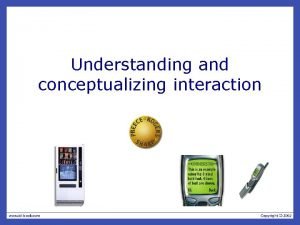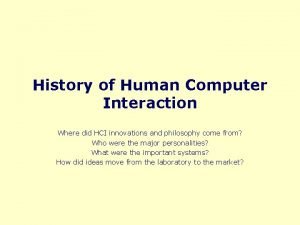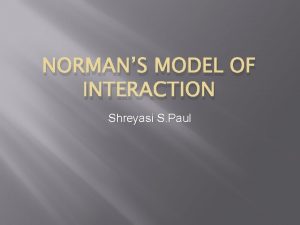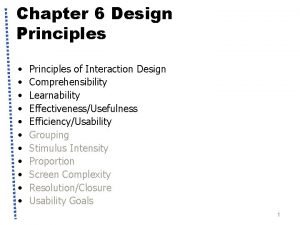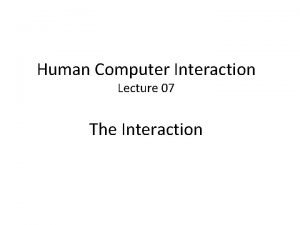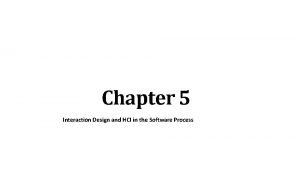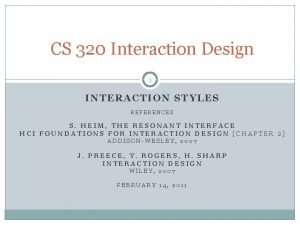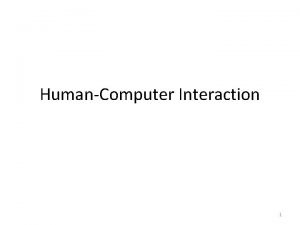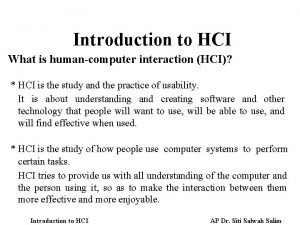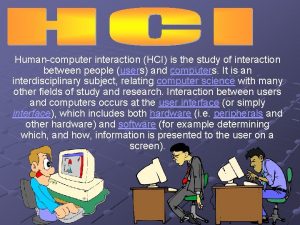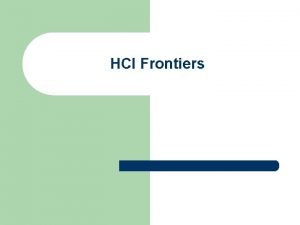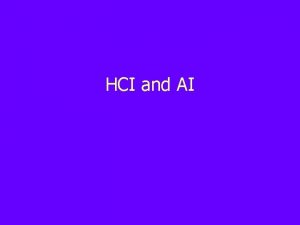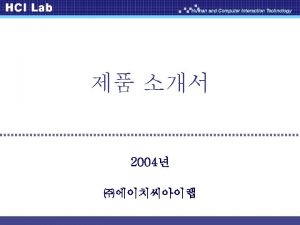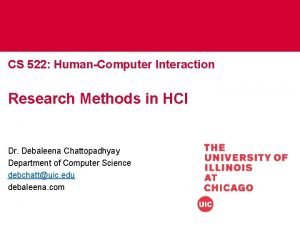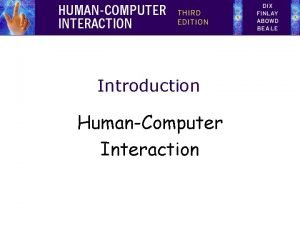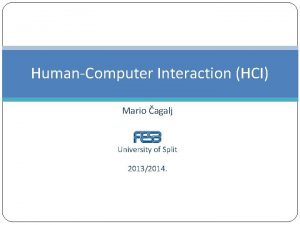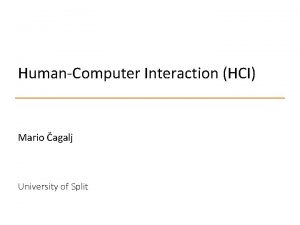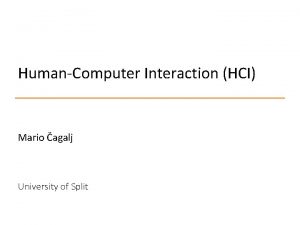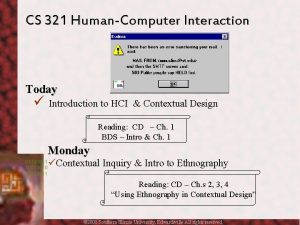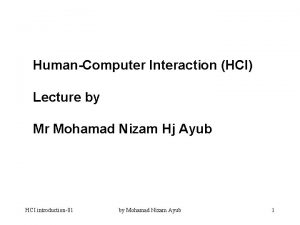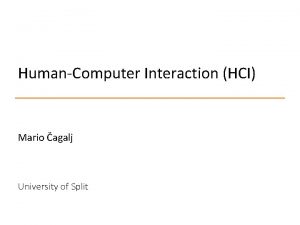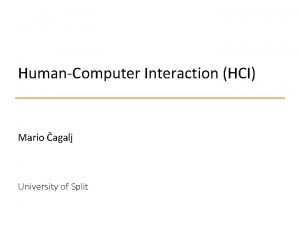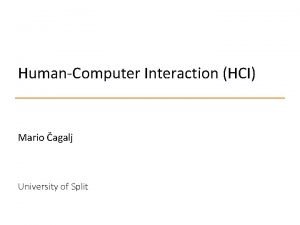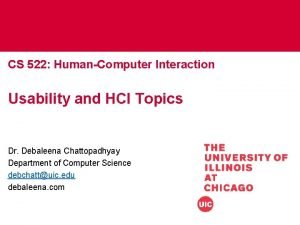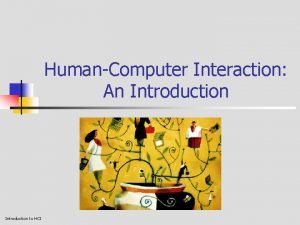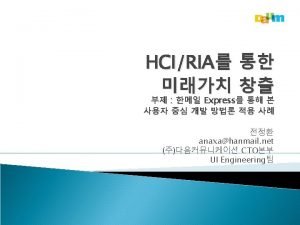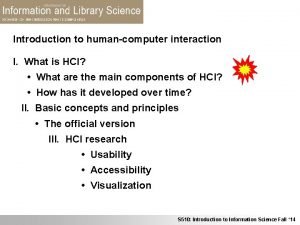HumanComputer Interaction Humancomputer interaction HCI is the study


























- Slides: 26

Human-Computer Interaction Human-computer interaction (HCI) is the study of the interaction between people and computers. Such interaction is mainly done at the user interface. One of the major concerns of professional practitioners in the field of HCI is the design of interactive computing systems for human use. As a result, it is a basic goal of HCI designers to make computers more usable and HCI Prof. Dr. Hussein Rady 1

more receptive to the user’s needs. To provide the best possible interface within given constraints, the HCI designers are supposed to develop systems that minimize the barrier between the human’s cognitive model of what users want to accomplish and the computer’s understanding of the users’ task. Interaction between users and computers occurs at the user interface, including both hardware and software. Interaction design means designing interactive products to support people in their everyday and working lives. HCI Prof. Dr. Hussein Rady 2

Because HCI concerns a human and a machine in conjunction with each other, designing a user interface requires knowledge on both the human and the machine side. Most researchers in HCI take interest in developing new design methodologies, experiencing with new hardware devices, prototyping new software systems, and exploring new paradigms for interaction. Designs in HCI aim to create user interfaces which can be operated with ease and efficiency. HCI Prof. Dr. Hussein Rady 3

Mobile devices play an important role in the modern society. They are being used by people for various purposes. They can be found in the fields of education, entertainment, medicine, communication service, military systems, and so on. Due to the multidisciplinary nature of HCI, designing user interfaces for mobile devices poses several interactive challenges. Some of these challenges are hardware-related, while the others software-related. HCI Prof. Dr. Hussein Rady 4

Interaction design: is defined as “designing interactive products to support the way people communicate and interact in their everyday and working lives. On the other hand, interaction design is the discipline of defining the behavior of products and systems in response to their users. HCI has developed mostly along two competing methodologies: direct manipulation and intelligent agents. These approaches can be contrasted as the computer sitting passively waiting for input from the human versus the HCI Prof. Dr. Hussein Rady 5

computer taking over from the human. Another dimension for HCI is that of affective computing. Affective computing is concerned with the means to recognize “emotional intelligence”. In contrast to the established paradigms of direct manipulation and intelligent agents, Intelligent Human Computer Interaction (IHCI) uses computer intelligence to increase the bandwidth through which humans interact with computers. Ubiquitous or pervasive computing , a new metaphor for computing, provides users constant access to information and HCI Prof. Dr. Hussein Rady 6

Computation in the form of mobile and wireless computing devices-Personal Digital Assistants (PDAs), such as cell phones, wearable computers and appliances – that are endowed with intuitive user interfaces. IHCI makes ubiquitous computing possible by continuously adapting the interface medium to meet specific users needs and demands. HCI Prof. Dr. Hussein Rady 7

Thinking: Reasoning and Problem Solving Humans are able to use information to reason and solve problems, and indeed do these activities when the information is partial or unavailable. Thinking can require different amounts of knowledge. Some thinking activities are very directed and the knowledge is constrained. Others require vast amounts of knowledge from different domains. In this section we will consider two categories of HCI Prof. Dr. Hussein Rady 8

thinking: reasoning and problem solving. 1. Reasoning is the process by which we use the knowledge we have to draw conclusions or infer something new about the domain of interest. There a number of different types of reasoning: deductive, inductive and abductive. 2 - Problem solving If reasoning is a means of inferring new information from what is already known, problem solving is the process of finding a solution to an HCI Prof. Dr. Hussein Rady 9

Unfamiliar task, using the knowledge we have. Human problem solving is characterized by the ability to adapt the information we have to deal with new situations. The problem solving centers on the problem space. The problem space comprises problem states, and problem solving involves generating these states using legal state transition operators. The problem has an initial state and a goal state and people use the operators to move from the former to the latter. HCI Prof. Dr. Hussein Rady 10

Emotion: our emotional response to situations affects how we perform. For example, positive emotions enable us to think more creatively, to solve complex problems, whereas negative emotion pushes us into narrow, focused thinking. A problem that may be easy to solve when we are relaxed, will become difficult if we are frustrated or afraid. HCI Prof. Dr. Hussein Rady 11

HCI in the engineering development life-cycle Figure(1) shows the traditional view of engineering development as a process of successive refinement from an initial specification. The various design stages proceed sequentially, although iteration is expected in the implementation and debugging stages and may also involve system analysis and development and production if serious design defects are uncovered. Documentation of all stages of the project is essential to ensure smooth transition HCI Prof. Dr. Hussein Rady 12

Specification Feasibility evaluation System analysis / development Implementation Documentation Debugging Production Maintenance Figure(1): Typical engineering development life-cycle. HCI Prof. Dr. Hussein Rady 13

from one stage to the next, and normally constitutes a major component of the project as a whole. Figure(2) shows how an awareness of HCI design guidelines can be exploited at various stages in this development cycle. an awareness of basic human characteristics allows additional human factors issues to be taken into account at the feasibility analysis and system analysis and development stages. In addition, it can be used to hypothesize dialogue guidelines on which user interface designs can be used. Many of these HCI Prof. Dr. Hussein Rady 14

Simple cognitive/ perceptual models Specification Feasibility evaluation Dialogue guidelines System analysis / development Implementation Documentation Debugging Production Informal evaluation Maintenance Figure(2): Engineering development life-cycle with added HCI awareness. HCI Prof. Dr. Hussein Rady 15

HCI Prof. Dr. Hussein Rady 16

Guidelines have been reaffirmed by extensive empirical evaluation with practical systems, and may thus be regarded as reasonably robust. The guidelines are restricted in their range of application, and cannot generally be relied upon in creative new interface environments, but will prevent designers from reinventing the worst human interface blunders of previous systems. Informal evaluation techniques provide guidance on methods which can be used to make valid assessments of interface designs, to avoid HCI Prof. Dr. Hussein Rady 17

invalidating pitfalls, and to emphasize the rapid extraction of information at the earliest possible stage(s) in the design cycle. A key aspect of HCI design methodology has been recognition of the importance of iterative interface prototyping as part of this process. Although specialist software support tools are available, with many simple menu-and form-driven systems, simulation of the user interface can readily be achieved and evaluated long before the underlying functionality of the system has been implemented. Lastly, the HCI Prof. Dr. Hussein Rady 18

‘awareness’ level provides an appreciation of the limitations of the guidelines and techniques presented, and pointers indicating how to invoke the ‘practitioner’ level of HCI design support. Figure(3) shows a variety of ways in which practitioner and specialist level knowledge can be applied to the development life-cycle. Within the conventional development life-cycle, task analysis and user modelling can be applied at the earliest level of system specification to model the user’s activity in undertaking a task, to analyze HCI Prof. Dr. Hussein Rady 19

and generalize their activities, and to define a framework for modelling the task within the system. Formal specification techniques, an amalgam of ideas from computer science, linguistics, and psychology, provide the basis of a number of methods of modelling human-computer dialogues and tasks formally. Many dialogue systems which have been constructed as research vehicles are also based upon formal dialogue specification techniques, HCI Prof. Dr. Hussein Rady 20

Task analysis/ User modelling Specification Formal specification of HCI Feasibility evaluation System analysis / development Implementation Dialogue design tools Documentation Debugging Formal evaluation techniques Production Maintenance and user documentation standards Maintenance Figure(3): Engineering development life-cycle with added HCI practitioners and specialists. HCI Prof. Dr. Hussein Rady 21

and in some cases these systems have been further developed to provide dialogue design tools for rapid prototyping of interfaces. An important feature of these dialogue design tools has been their incorporation of automatic mechanisms for monitoring user interaction, to allow subsequent review and evaluation of user performance. Formal evaluation techniques, originating from experimental psychology, provide a methodology for evaluating human-computer systems in terms of both objective performance measures(e. g. , time HCI Prof. Dr. Hussein Rady 22

To complete tasks, error performance) and subjective opinions (user satisfaction ratings, etc. ). Their emphasis is upon carrying out small-scale structured experiments as early as possible in the design cycle to provide early user feedback, minimize evaluation costs and maximize the number of possible prototyping iterations. At this level, the only valid benchmark for a system is the target application itself. Finally, in recognition of the importance of documentation for users and for system maintenance, there is considerable research activity in defining documentation techniques (both on –and off-line). HCI Prof. Dr. Hussein Rady 23

Providing these additional methods over and above the basic ‘awareness’ level offers an increased opportunity for creativity in the HCI design process. Designers can now investigate more unusual solutions to their problems armed with techniques which enable them to evaluate and compare alternative solutions, and to establish whether appropriate performance standards and criteria are met. In summary, the awareness level provides the basis for a ‘first-guess’ design; the ‘practitioner’ level provides HCI Prof. Dr. Hussein Rady 24

support formalizing, iterating and evaluating this design to produce an optimum solution. HCI Prof. Dr. Hussein Rady 25

HCI Prof. Dr. Hussein Rady 26
 Emotional interaction in hci
Emotional interaction in hci Hci conceptual model
Hci conceptual model Interaction framework in hci
Interaction framework in hci Modelling rich interaction
Modelling rich interaction Donald norman’s model
Donald norman’s model Interaction framework in hci
Interaction framework in hci Areas of the screen that behave as if they were independent
Areas of the screen that behave as if they were independent Modeling rich interaction in hci
Modeling rich interaction in hci Formality gap in hci
Formality gap in hci Interaction styles examples
Interaction styles examples What are paradigms in hci
What are paradigms in hci Chó sói
Chó sói Thiếu nhi thế giới liên hoan
Thiếu nhi thế giới liên hoan Bảng số nguyên tố lớn hơn 1000
Bảng số nguyên tố lớn hơn 1000 Tỉ lệ cơ thể trẻ em
Tỉ lệ cơ thể trẻ em Fecboak
Fecboak Các châu lục và đại dương trên thế giới
Các châu lục và đại dương trên thế giới Thế nào là hệ số cao nhất
Thế nào là hệ số cao nhất Hệ hô hấp
Hệ hô hấp Tư thế ngồi viết
Tư thế ngồi viết Hát kết hợp bộ gõ cơ thể
Hát kết hợp bộ gõ cơ thể đặc điểm cơ thể của người tối cổ
đặc điểm cơ thể của người tối cổ Mật thư tọa độ 5x5
Mật thư tọa độ 5x5 Chụp tư thế worms-breton
Chụp tư thế worms-breton ưu thế lai là gì
ưu thế lai là gì Tư thế ngồi viết
Tư thế ngồi viết Thẻ vin
Thẻ vin

